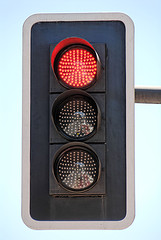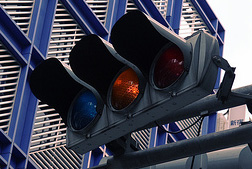
I have a drivers license for more than ten years now. When I applied for it I didn’t had to take a color blindness test. This is maybe the reason why I have one…
The question most people think about when they hear, that someone who is colorblind and does have a drivers license is: “How do you know when to stop at the traffic light?” And they don’t stop thinking here but start to find a reason themselves.
People conclude that if you are colorblind you know, red is on top, green at the bottom and that’s the way colorblind people find their way through the traffic jungle. But that’s wrong.
Why is it wrong?
- The association between top and stop, bottom and go is to weak.
- The connection for deciding what to do is not fast enough.
- The thought needs to many steps. Light – top – stop is one step to much.
So what do you do if you are colorblind?
Colorblind doesn’t mean you can’t see colors at all. You can see colors, differences in hue, saturation and lightness. Maybe not as good as with normal vision, but you definitely have a broader vision than just black, white and gray. And because of that, people suffering from color blindness do see different colors at the traffic light. Some more differences, some less and maybe not the same difference in color as people with normal vision. But all you have to learn is which color you see relates to which reaction.
If you are colorblind you know this color means stop and that color means go. You don’t know the name of the color. You maybe can’t relate the colors you see at the traffic light with other colors in the nature. You even may give them other names. But you will always know the difference because you can see a difference.

If you are not affected by color blindness I suppose all this is hard to imagine. Have a look at some pics and help your imagination. Some pics are about Walk – Don’t Walk pedestrian lights, modulated to show different color vision deficiencies.
By the way, there are many traffic lights not only from top (red) to bottom (green) but from left (red) to right (green). If you would just remember the sides, you definitely would mix them up all the time.

As a protanope, my main problem with traffic lights is just that the red light is so dim. I can easily tell green from red, and easily see the green light. But if I approach an intersection and the light is red, I sometimes have to search around to find where the light is. This is especially hard in a busy city intersection where there are a lot of other lights all over.
Interesting articles:
http://dx.doi.org/10.1007/BF00137452
http://www.hubmed.org/search.cgi?q=12135418
Peter, I have the same ‘problem’. The red light doesn’t stick out that much and this makes it sometimes hard to spot it. Thanks for the interesting links. The experts don’t agree if you should exclude colorblind (specially red-blind) people from road traffic or not. Why don’t they try to find a solution for the traffic lights?
The new LED red traffic lights solve this problem (for me at least) because they are so much brighter. I can see the red LED traffic lights, even in bright sunlight, for blocks away. They really stick out. Old-style traffic lights, a bulb with a red filter, blend into the background and don’t look lit in bright sunlight.
My problem is with the red and yellow lights. From a distance, I cant really tell the difference between the two colors. This is especially dangerous for me when approaching a flashing red/yellow light as I cant tell which one it is until I am close enough to pinpoint its placement in the stack.
I have the same problem as Gilzow. I was surprised that this wasn’t mentioned in the main article. I am red-green color blind (all I have ever known to call it). I can’t easily tell the difference between the red and yellow colors and I do rely on position to tell the difference. As Gilzow said, this is a serious problem for flashing lights. Approaching a yellow traffic light from a distance will always necessitate a (eventual) stop, so it is easy to cope with. But misinterpreting a flashing light can result in unexpectedly stopping in traffic or not stoping when it is required.
Red and green traffic lights are quite easy to distinguish for me because in my estimation, the red light is much more saturated and less luminous than the green. Thus the green light usually looks brighter and nearly colorless (white) to me.
these lights are really awake about his duty into the walk on the road why lights on the road which messages they give to us when you understanding about them many people ignore about them
these lights are most important on road to signals
I am a deutan. My problem is the same as that of Gilzow and Jason. It is quite easy to distinguish red and green lights, but a little difficult to distinguish red and yellow.
I completely agree with the Red and Yellow. I have been pulled over before for running a flashing red light. I thought it was yellow. I had no idea that I had even done anything wrong. I have to be sure that I have someone in the car with me when it’s late and I know that I will be in an area of town that has the lights flashing after-hours. I just don’t want to go to driving school again because I know if I was by myself then there is a high possible that it can happen again.
I am color blind and didn’t know it.
Paraguayan trafficligth colorblind, a good invention
http://daltonicosnoanonimos.org/index.php?option=com_content&view=article&id=121:semaforo-daltonicos&catid=40:daltonoticias&Itemid=63
Pingback: My True Colours | David Wen
I’m colorblind and always look for the position of the lit light relatave to the pole, because that’s something I can see well even at night; but recently they’ve started changing that position.
Traditionally the red light was above the support pole, and the yellow and then green below it. These days many new standards where I live aren’t being built that way anymore.
This change is dangerous especially at night when the only light a color blind person might see is the one that’s lit. You can’t tell if it’s at the top or bottom if you can’t see the other lights.
You’re headlights almost always light up the pole a little so you can usually see it much more easily from a distance, than you can see the other lights.
What happens when there’s just red, yellow and green light, no flashing red or yello lights,can the colour blind drive safely then? Like the lights in Singapore.Will there be any problems?
I’m color blind and i’m so worried about it. coz every time i cross a intersection when the sun is high in the sky and bright so i can’t see the lights they all look off them. for months i thought they are out of order and they didn’t switch it. but now i figure it out i have a problem and that i i can’t not see them in the brighter light?
So is there any solution except the one changing the traffic lights?
Regards,
Pingback: Web Blog / Be Kind to the Color Blind by COLOURlovers :: COLOURlovers
Color blind people CAN see variations in color. For me there are certain shades of green that look grey (mint green) or blue (teal). But I can see kelly green (like the color of grass). Every color blind person I have talked to seems to see colors exactly like I do. Why not tint the green light to a color we can see so we don’t get it confused with the street light. Non color blind people won’t be affected at all.
if you really need to become expert in driving, your really need to enroll in a driving school ‘.,
Pingback: Be Kind to the Color Blind | JustMyLog.info
Nobody has touched on my problem. I’m red-green colorblind as well, but cannot distinguish between GREEN LIGHTS and post-dusk STREET LIGHTS.
Green traffic lights, to me, do not look *anything* close to green. At all. They look white, just light street lights.
Not a problem if all traffic lights hang over the middle of each road, but quite a few US cities, they are positioned to the right of the road between a series of street lights.
Seriously. Nobody else has this problem? I’ve pondered this one for years.
Oh, I just read all the comments above – I’m not alone with this problem.
Daniel, how prevelant are traffic lights in the area you do most of your driving? And under what conditions. While many variables may affect driving performance more than colour vision (such as visual acuity, depth perception and field of vision), but a colour normal person (or even one with a mild green or blue weakness) would surely have better situational awareness if all other variables are equal.
“This change is dangerous especially at night when the only light a color blind person might see is the one that’s lit. You can’t tell if it’s at the top or bottom if you can’t see the other lights.”
Here’s a question, say you misread a traffic light at night and you are carryring passengers, one of them is also licensd to drive and let’s say you are both equal in all other vairables that affect driving performance more than colour vision. Or let’s say your depth perception is less than them bust still enough to be legally permitted to drive.
Does the blame lie within the change of the position of the light or the choice of driver?